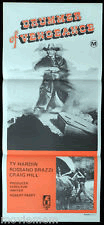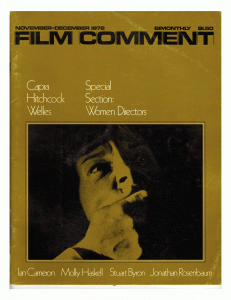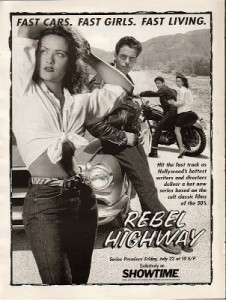From the Chicago Reader (November 18, 1994). — J.R.
You can figure out a lot about the differences between our culture and French culture by comparing two current series of low-budget TV features about teenagers. The French series, Tous les garcons et les filles de leur age (“All the Boys and Girls of Their Age”), produced by the French “cultural” channel Arte, has yielded half a dozen features, most of them first-rate. The idea is for the filmmaker to make a fictionalized version of his or her own teenage years set in the appropriate period (different in each film) and to include at least one party scene in which pop songs of that era are used. (The series is financed in part by Polygram, which has furnished the appropriate recordings.) The first of these, Patricia Mazuy’s Travolta and Me, showed at last year’s Chicago International Film Festival; four others were programmed at the festival last month — Olivier Assayas’ Cold Water, André Téchiné’s Wild Reeds, Cedric Kahn’s Too Much Happiness, and Chantal Akerman’s Portrait of a Young Girl From Brussels — but unfortunately the first and best of these was canceled at the last minute. One more, Claire Denis’ Boom Boom [later retitled U.S. Read more
From Monthly Film Bulletin, October 1974 (vol. 41, no. 489). –- J.R.
Drummer of Vengeance
Great Britain, 1974
Director: Robert Paget
 The American West, shortly after the Civil War. A rebel soldier who goes over to the Union army returns home to find his Indian wife and his son murdered — the former after having been raped — and their house burned to the ground by vengeful Confederates. Coming upon a wind-up toy drummer in the ruins, he vows to track down and kill all the men responsible. His usual method of revenge is to wind up the toy, place it on the ground, and ask his victim to make his play — whether armed or unarmed – before shooting him. He pays a carpenter to make the necessary coffins in advance and quickly dispatches six of the men he is after. The angry townsfolk, eager to be rid of the avenger (known only as the Stranger) and anxious for Sheriff Mason to apprehend him, are spurred on by the fanatical Bible-spouting of the town’s gravedigger — actually the Stranger in disguise. The Stranger also impersonates an Indian in a lance-throwing act in O’Conner’s Travelling Show in order to kill his next victim. Read more
The American West, shortly after the Civil War. A rebel soldier who goes over to the Union army returns home to find his Indian wife and his son murdered — the former after having been raped — and their house burned to the ground by vengeful Confederates. Coming upon a wind-up toy drummer in the ruins, he vows to track down and kill all the men responsible. His usual method of revenge is to wind up the toy, place it on the ground, and ask his victim to make his play — whether armed or unarmed – before shooting him. He pays a carpenter to make the necessary coffins in advance and quickly dispatches six of the men he is after. The angry townsfolk, eager to be rid of the avenger (known only as the Stranger) and anxious for Sheriff Mason to apprehend him, are spurred on by the fanatical Bible-spouting of the town’s gravedigger — actually the Stranger in disguise. The Stranger also impersonates an Indian in a lance-throwing act in O’Conner’s Travelling Show in order to kill his next victim. Read more
From Film Comment, November-December 1972 and Discovering Orson Welles (California, 2007) — the latter of which includes the following introduction. My apologies for some occasional glitches in the formatting, which I haven’t managed to rectify. — J.R.

The following article was inspired by my having been lent Welles’s first film script by the late, Cuban-born film critic Carlos Clarens while we were both living in Paris. This was supplemented eventually by my meeting with Welles, and initially by research in the library at that city’s American Center and correspondence with Richard Wilson, a longtime Welles associate who was probably unique among his close collaborators in his scholarly meticulousness (as evidenced in his suberb rebuttal to an article by Charles Higham about IT’S ALL TRUE, appropriately entitled “It’s Not Quite All True,” in the Autumn 1970 issue of Sight and Sound — an essay that lamentably had no sequels)
As a former graduate student at the State University of New York at Stony Brook in English and American Literature (1966-69) who had dropped out shortly before moving to Paris, I was still somewhat under the sway of that academic training when I wrote this piece, which partially accounts for its literary orientation. Read more




